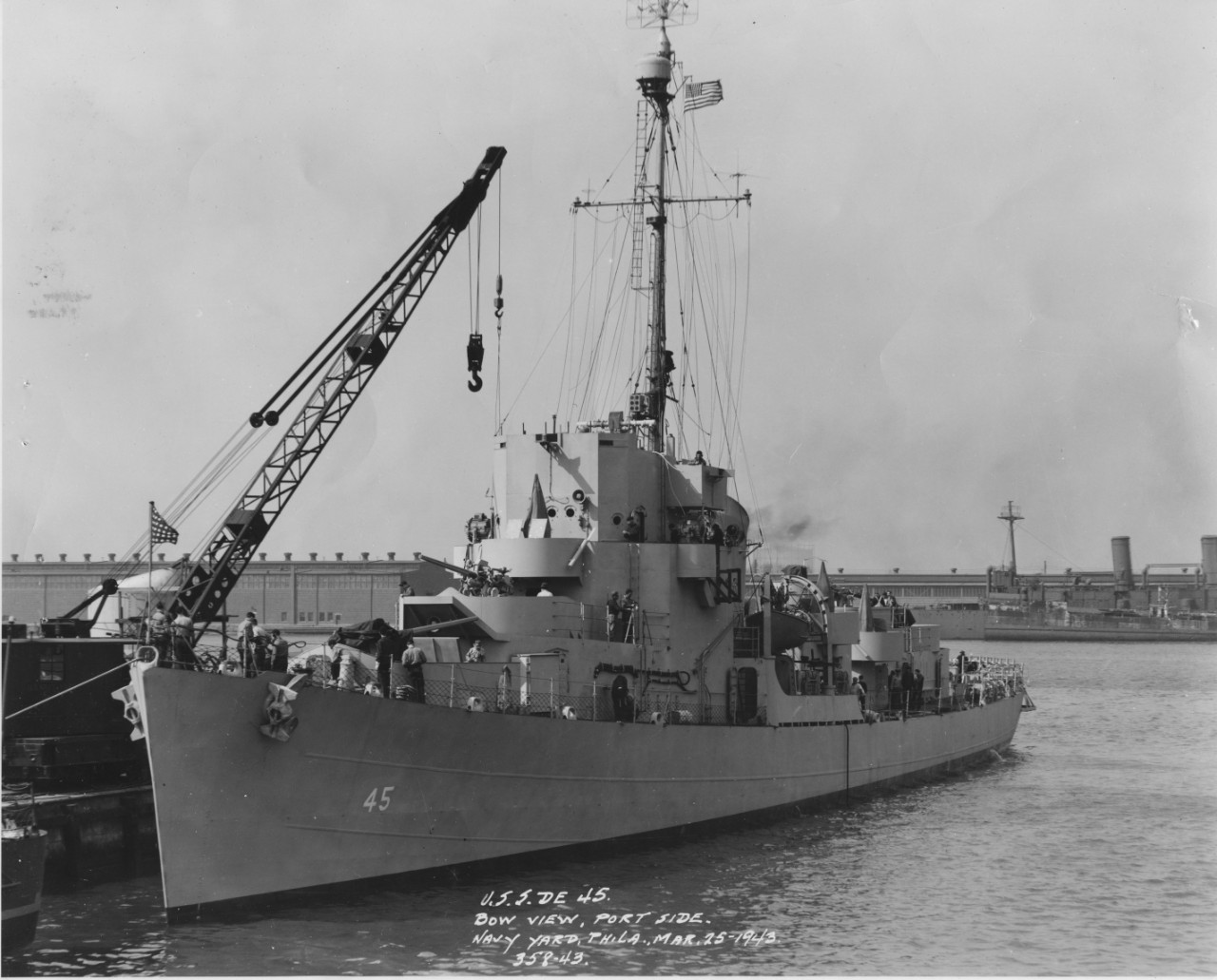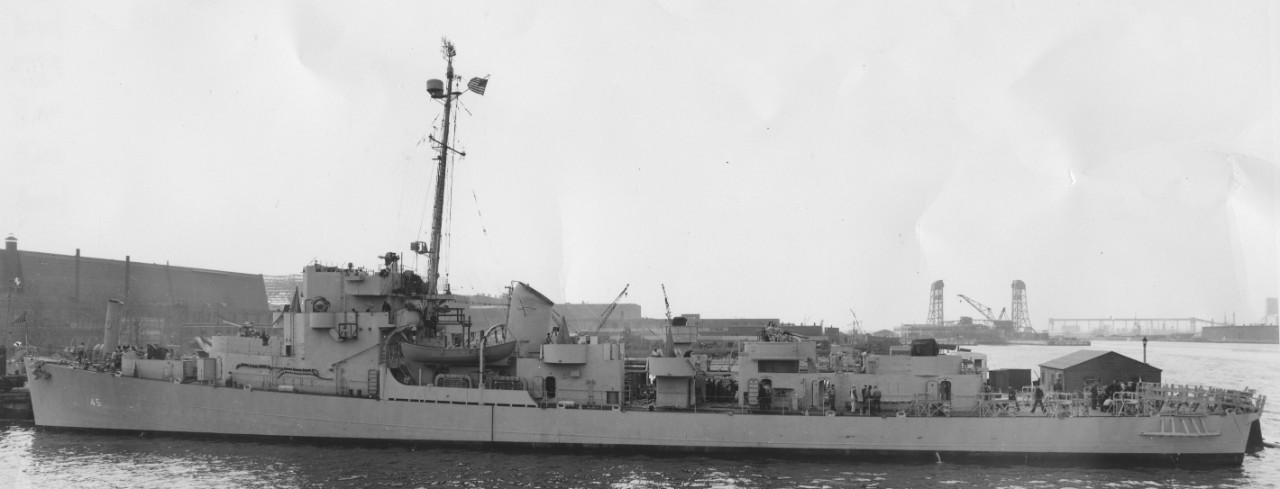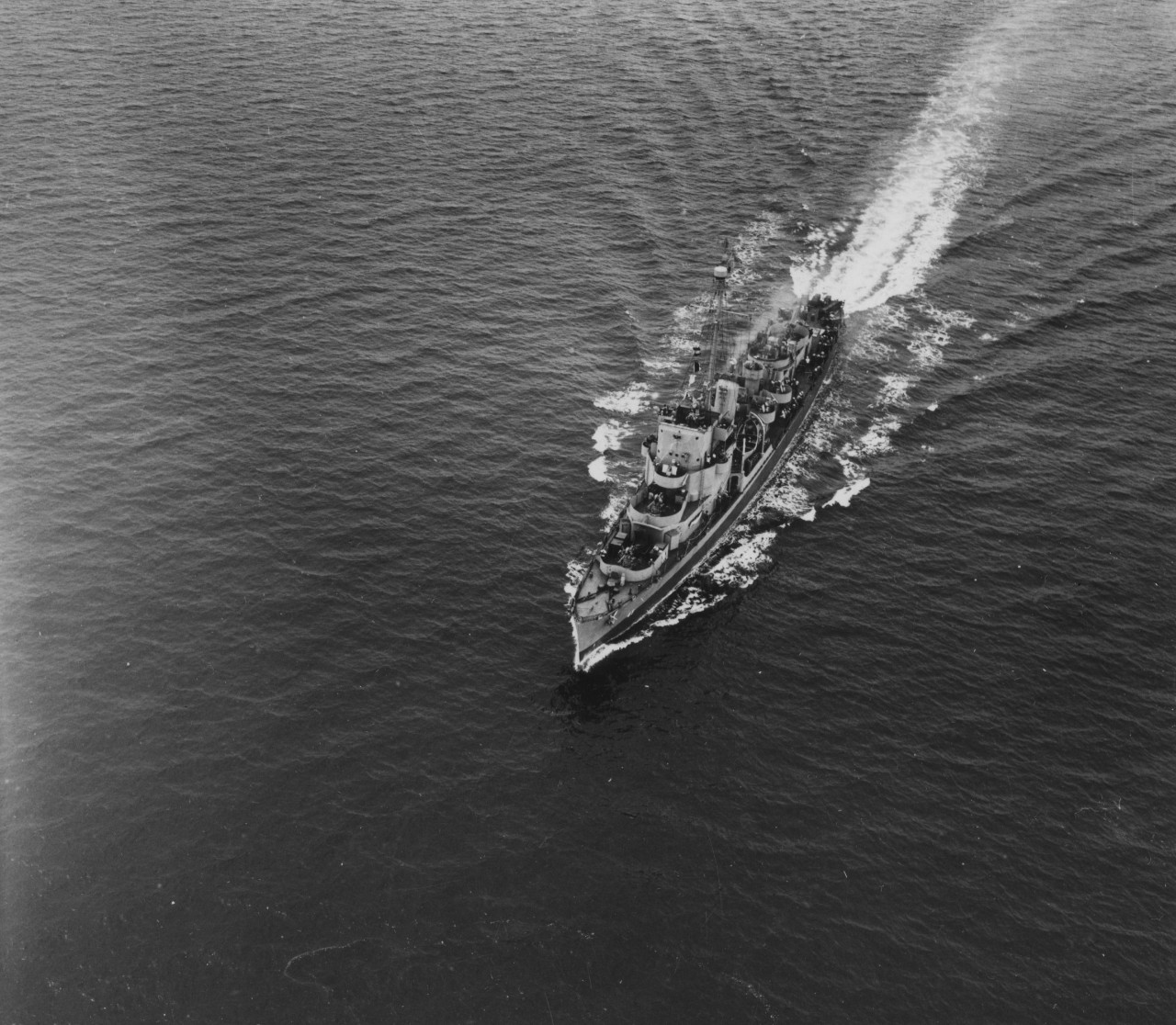Andres (DE-45)
1943-1945
Eric Theodore Andres was born on 12 May 1915 in Flint, Mich., to Reverend Theodore and Vera Marie Andres. Reverend Andres moved the family to Valparaiso, Ind., when he accepted a position on the business staff of the public relations department for Valparaiso University. Eric enrolled in the university in 1933. While he was a student, Andres actively participated in athletics, extracurricular activities and student government. During his freshman year, he made the university football team, on which he eventually secured a quarterback position and pledged the fraternity Phi Delta Kappa. In his junior year, Andres was elected to be a representative to the university student council. The following year, he became the Chairman of the Lecture and Entertainment Committee, President of the Liberal Arts College and Vice President of the Commerce Club. According to a profile of Andres in The Torch, the university newspaper, he expressed that he feared “punching a time-clock twice daily, when, in reality, he yearns to sling a pack over his shoulder and tramp of across country or slip onto a tramp steamer to Honolulu.” In June 1933, he earned a Bachelor of Arts in Business after which he accepted a position with Sears Roebuck in Chicago, Illinois.
Andres enlisted in the U.S. Naval Reserve as an apprentice seaman on 25 October 1941. In January 1942, he entered the U.S. Naval Reserve Midshipmen’s School at Northwestern University in Chicago. On 13 February 1942, Andres was appointed as a midshipman to begin his officer training which he completed (15 May) and was appointed ensign in the U.S. Naval Reserve.
Upon commissioning, he was placed on active duty and assigned to the heavy cruiser Astoria (CA-34) of the Pacific Fleet. Astoria was serving as part of Task Force (TF) 17 formed around the carrier Yorktown (CV-5). She had returned to Pearl Harbor after Yorktown had been badly damaged in the Battle of Coral Sea (4-8 May 1942). On 30 May, Andres put to sea in Astoria as TF-17 returned to combat to confront the Japanese at Midway, after which Andres’ ship was back in Pearl Harbor (13 June 1942), awaiting her next combat assignment.
In August, Astoria was reassigned to Task Group 62.3 (TG 62.3), a Fire Support Group, for the amphibious assault on Guadalcanal. Late on 8 August, while Astoria steamed off the coast of Guadalcanal, a Japanese force under the command of Rear Adm. Mikawa Gunichi transited the waters off Savo Island and surprised the Allied Forces. Astoria and her sister ships Quincy (CA-39) and Vincennes (CA-44), the Australian heavy cruiser HMAS Canberra, and the destroyers Helm (DD-388) and Wilson (DD-408) were caught entirely off guard. The attack proved quick and brutal, giving the ships little time to return fire before Japanese retired.
A short time into the engagement, Astoria had sustained mortal damage and was almost fully ablaze. After a valiant attempt by the crew to save her, Astoria sank at 1215 on 9 August 1942, taking Andres and 215 of his shipmates with her. In a memorial ceremony at Andres’ alma mater, Capt. William Greenman, Astoria’s commanding officer, stated that Andres, “unquestionably died at his post of duty with the single thought of inflicting maximum damage on the enemy with entire disregard to his personal safety.”
(DE-45: displacement 1,140; length 289'5"; beam 35'2"; draft 11'; speed 21.5 knots; complement 156; armament 3 3-inch, 4 40 millimeter, 5 20 millimeter, 2 depth charge tracks, 8 depth charge projectors, 1 depth charge projector (hedgehog); class Evarts)
Capel (BDE-15), earmarked for transfer to Great Britain under Lend-Lease, was laid down by the Philadelphia [Pa.] Navy Yard on 12 February 1942; launched on 24 July 1942; sponsored by Miss Mary Elizabeth Schumacher, the daughter of Capt. Theodore L. Schumacher, commandant of the Philadelphia Navy Yard; reallocated to the U.S. Navy in January 1943, and renamed Andres; she was commissioned on 15 March 1943, Lt. Cmdr. Clayton R. Simmers in command.


After fitting out, Andres got underway for her final acceptance trials, transiting the Delaware River into Delaware Bay. Accepted for service on 28 March 1943, she sailed on 2 April for Lewes, Del. to conduct systems tests and general quarters drills (3-6 April 1943) before sailing for Naval Operating Base (NOB) Norfolk on 7 April. Once she lay moored at Norfolk (8 April), Andres was assigned to Destroyer Escort Shakedown Group (CTG) 23.1 Two days later, she got underway in company with destroyer tender Hamul (AD-20) and the destroyers Benson (DD-421) and Laub (DD-613) en route to Great Sound, Bermuda. En route, the ships steered zig-zag courses in view of U-boats known to be operating along the eastern seaboard. Once the formation reached Bermuda, they were joined by the submarine R-15 (SS-92) to begin training in antisubmarine warfare tactics in the George I operating area (13-30 May).
While returning to Philadelphia on the early evening of 4 May 1943, Andres spotted a signal rocket off her port bow. She steered toward the signal, and soon came upon three life rafts lashed together carrying 28 merchant seamen and three U.S. Navy sailors, who had been in U.S. Army Transport Oneida in a convoy steaming to Guantanamo Bay from New York. The assembled ships had encountered bad weather, during which Oneida became separated from the formation, then began taking on water, foundering in the early morning hours of 4 May off Cape Charles, Virginia. After taking the survivors, Andres resumed her voyage to Philadelphia, mooring on 5 May, disembarking the 31 survivors from Oneida. On 10 May, she was drydocked for maintenance and upkeep.
Once out of yard hands, Andres continued training and testing her systems off Rockland, Maine, and New London, Conn. (18-25 May 1943). On 29 May, she moored at the New York Navy Yard where she received her first duty assignment to serve as a school ship at the Submarine Chaser Training School (SCTS) in Miami, Florida. Prior to departing for Miami (1 June), Lt. Cmdr. Simmers was relieved of command of Andres by Lt. Cmdr. Jasper N. McDonald. Andres departed New York on 6 June arriving at the SCTS on 10 June. On 14 June, she began her assignment training nucleus crews and young surface officers embarking three student officers. She was underway that same day to commence training en route to Havana, Cuba, where she moored on 16 June. Over the next eighteen months, Andres mainly operated out of Miami, in the Dry Tortugas, often in company of Reuben James (DE-153), Brennan (DE-13), Edgar G. Chase (DE-16) and a wide range of PC-461-class submarine chasers.
Although her operations followed a routine pattern, there were movements of intense excitement. On 31 July 1943, on a return voyage from the Dry Tortugas to Miami, her convoy made radar contact with serval vessels cruising in a darkened condition off the coast of Marathon, Florida. It was quickly determined the formation was a friendly convoy under destroyer escort. The escorting ships turned on their running lights to mark their position for Andres’ approaching formation. The convoy was passing starboard to port. Shortly afterward, Andres received word that Reuben James had collided with one of the passing convoy’s merchant ships, Demarzo. Andres reversed course to provide assistance. Both ships were not severely damaged and were able to remain afloat. Andres accompanied the ships to Key West before returning to her berth at Miami later the same day.
Several months later (22 October 1943) Andres was dispatched to ply her trade, along with Edgar G. Chase, when it was reported that a U-boat was attacking passing convoys near the Florida Keys. While conducting the search, the pair was joined by Joyce (DE-317). Unable to locate the enemy, the search was abandoned after several hours. Andres returned to her training schedule.
On 5 December 1943, Andres set sail for the Charleston (S.C.) Navy Yard for upkeep, repairs and installation of additional equipment (6-15 December). During that maintenance period, her main engines were overhauled and four additional 20 millimeter guns were installed. She also received a high frequency radio direction finder, known as a DAQ, which could be used to hunt U-boats using their radio transmission to pinpoint their positions. In addition to her new weapons and technology, her bow was reinforced for the purpose of ramming U-boats. She returned to Miami on 19 December, but while operating near Gun Cay that day, in the vicinity of the Bimini Islands, she received a confidential dispatch from the SCTS ordering her, and Reuben James, to investigate a U-boat sighting in the area. The two ships searched near the reported coordinates from 2020 to 0800 (20 December) before returning to the training schedule.
The following year, 1944, proved to be fairly uneventful as Andres continued her routine, but highly important, mission of training sailors to hunt and kill enemy submarines. Although U-boat operations in the Atlantic were waning in 1944, protecting convoys was vital to the continuing war effort. In June, Andres was under once again underway to Charleston for more extensive upkeep and overhauls (25 June-5 July). She returned to Miami on 8 July and resumed her training operations, then returned to Charleston in October for another period of maintenance (16-26 October). Andres concluded her duties at the SCTS when she got underway for the New York Navy Yard (28 November 1944) where she was reassigned to Escort Division 80 (CortDiv 80) of the Atlantic Fleet.

On 12 December, Andres reported to Escort Task Group (CTG 23.2) to begin training for duty escorting convoys across the Atlantic to the Strait of Gibraltar and into the Mediterranean, joined by Mason (DE-529), Herbert C. Jones (DE-137) and John M. Bermingham (DE-530). After a brief stay at Yorktown Naval Weapons Station where she loaded Mk. 8 depth charges, Andres reported for duty with CTG 64 at Norfolk, Va., (18 December 1944) for her first overseas deployment. Before she could get underway with convoy U.S. to Gibraltar (Slow) convoy UGS-64, however, it was discovered that Andres’ no. 2 3-inch gun (Mt. 32) was frozen in train and she was detached to remain in port for repairs. In the process of replacing the gun, investigation revealed that the ball bearings were cracked and broken but “not due to the lack of lubrication.” At noon on 19 December, Andres was finally underway, making haste to catch up with her assigned convoy en route to Gibraltar, and she made a rendezvous approximately 340 nautical miles east of Norfolk.
Andres rang in the New Year steaming with UGS-64, 865 nautical miles west of the Strait Of Gibraltar in the company of CortDiv 80 along with the destroyers Balch (DD-363), Livermore (DD-429), and Eberle (DD-430), and the frigate Gulfport (PF-20) of Task Force (TF) 64. At 0752 on 4 January 1945, as Andres approached the Strait, the convoy passed through an oil slick and reported sighting several life boats and rafts adrift -- the remnants of a merchant vessel that had been torpedoed the previous day. After entering the Mediterranean, the formation set course for Algeria. On 5 January, Andres was moored with Edgar G. Chase alongside the hulk of the French destroyer Épervier--driven aground at Oran, Algeria, on 9 November 1942--at Mers-al-Kébir, Algeria.
On 12 January 1945, Andres got underway with convoy Gibraltar to U.S. (Slow) convoy GUS-65 on her return voyage. Some 129 nautical miles west of Gibraltar, Andres received orders to come alongside the U.S. freighter Josiah Tattnall to investigate a situation on board. The ship master requested that Andres’ commanding officer, Lt. Cmdr. McDonald, come on board. McDonald declined but asked the master send a message describing the situation. Andres received a missive from one of the ship’s crew requesting that the master – whom the crew considered incompetent -- be removed from the vessel. Andres passed that information to the convoy commander, then resumed her original station.
After several days of relatively smooth sailing, the convoy encountered heavy weather 1,200 nautical miles east of the eastern seaboard (24 January 1945). To compensate for the high seas, Andres took on 49.5 tons of seawater for ballast that resulted in smoother sailing. As a result of the storm, the convoy began to straggle. On 27 January, the tempest abated but rough sea conditions continued. While Andres was receiving fuel from oiler Chiwawa (AO-68), the ships’ sterns were sucked into each other causing damage to Andres’ no. 6 and no. 8 depth charge roller loaders. The collision also fractured her main deck heading frames 144-145. Andres returned to her station screening for the convoy only to be detached at 2030 to divert a tanker from colliding with another convoy.
On 29 January 1945, the convoy split into two sections approximately 147 nautical miles off Virginia Beach, Va., and Andres, Eberle, Edgar G. Chase, in addition to Fleming (DE-32), formed the Chesapeake section returning to Norfolk. Livermore and John M. Bermingham formed the New York section. The Chesapeake section arrived at Norfolk on 1 February 1945 at 0542. After being relieved from escort duty, Eberle and Edgar G. Chase set sail for New York, and Andres anchored near the Statue of Liberty on 2 February at 2025, waiting to be berthed at the New York Navy Yard.
Andres spent the next several months escorting convoys from Norfolk to Oran and back with CortDiv 80. The majority of those voyages proved uneventful as the European campaign was drawing to a close. On many occasions, one of her partner ships would detect a surface contact on their radar. One of the escorts would detach to investigate only to discover it was a small rain squall. Not all incidents, however, were without potential danger. On 18 April 1945, while departing Norfolk with UGS-86, 65 nautical miles off Virginia Beach, Annapolis reported a sound contact off of her port bow. She immediately launched two depth charge patterns at 1617. The convoy executed an emergency 45° turn to starboard to evade potential attacks. Also in the vicinity were several Navy blimps and a few USAAF B-25 Mitchells providing air cover for the area. Intercepted voice communication between the planes indicated there had been reports of lifeboats in the water. It was later confirmed that a ship had been torpedoed 76 nautical miles northeast of the convoy at 1330 that afternoon. After safely escorting UGS-86 to Gibraltar, the formation split (3 May) and Andres, along with John M. Bermingham, continued on to Oran.
While conducting anti-submarine exercises with Edgar G. Chase, John M. Bermingham and French submarine Doris on 7 May 1945, Andres received the announcement that Germany had accepted the Allied terms for surrender. After being moored at Mers-el-Kébir (9-11 May 1945), Andres got underway to the convoy assembly area to join GUS-89 for what would be her last trans-Atlantic crossing. On 13 May, she transited the Strait of Gibraltar with 46 other vessels including Livermore, John M. Bermingham, Gulfport, and Edgar G. Chase. As the convoy made its way to the United States, each ship began to receive orders directing them where to proceed for berthing once relieved of escort duty. Andres returned to the New York Navy Yard on 29 May 1945 and immediately entered a period of upkeep.
On 12 July 1945, Andres, underway in Casco Bay in the vicinity of Portland, Maine, with CortDiv 80 along with John M. Bermingham, received orders from Commander, Destroyer Force, Atlantic (ComDesLant) to proceed to Miami, Florida, for assignment to the Naval Training Center as school ships. Subsequently, while underway conducting a training cruise in the Dry Tortugas, Andres received word that President Harry S Truman had announced the end of the war with Japan (14 August 1945).
On 8 September 1945, CortDiv 80 sailed for Charleston, and, two days later (10 September), was dissolved. Andres remained in Charleston and was decommissioned there at 0930 on 18 October 1945.
Stricken from the Naval Vessel Register on 1 November 1945, ex-Andres was sold for scrap in February 1946.
John W. Watts Jr.
23 September 2016


